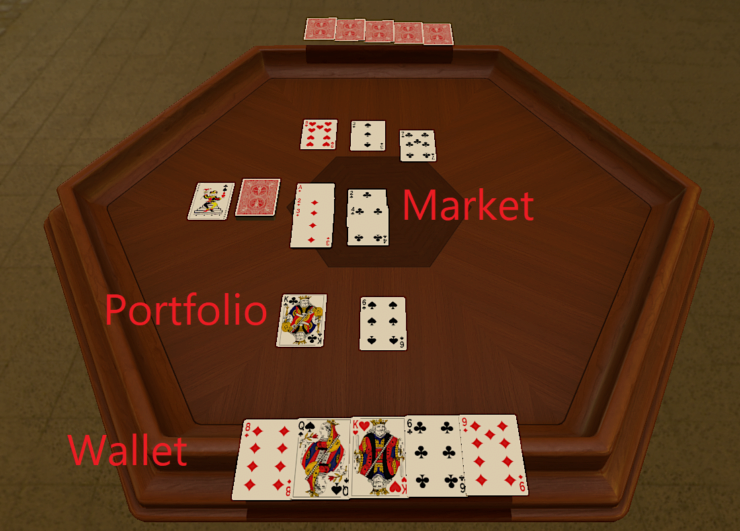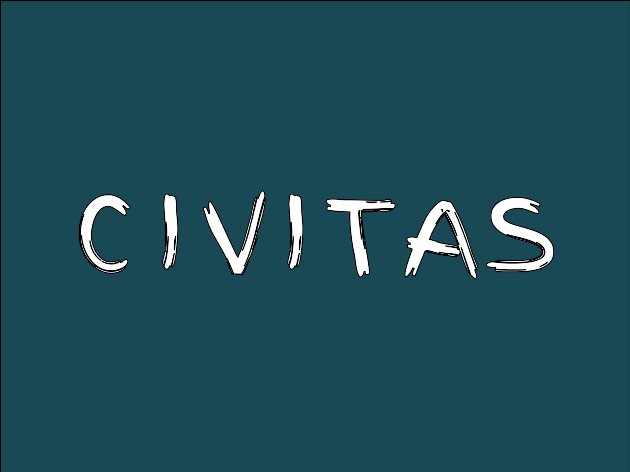Crypto Cards
Rules
Crypto Cards is multiplayer game about cryptocurrency that uses nothing but an ordinary deck of cards.
This is a draft of the rules. This game has not been playtested! If you'd like to help me out with that and have Tabletop Simulator, I'd love to teach you the game. If you try it on your own, please send me a report via email or the comment section.
Goal
The winner of Crypto Cards is the player who leaves the least value on the table. In game terms, that means having the smallest portfolio by selling the most crypto.
Setup
Remove the Jokers from an ordinary deck of cards, shuffle, and deal out 5 cards to each player. Shuffle two Jokers back into the deck and place it face down within reach of the players.
The four suits represent the 4 cryptos1 in this game:
- LUX (♢)
- LUK (♣)
- LUV (♡)
- LUT (♠)

Turns
The player who has most recently bought, sold or mined a cryptocurrency or NFT goes first. Play continues clockwise around the table.
On their turn, each player must mine and transfer one crypto. They may also be able to sell a crypto into the marketplace.
1. Sell
Players can sell a card from the portfolio by moving it from their portfolio to the corresponding crypto market. Cards may not be sold directly from the player's hand, but only from cards displayed in their portfolio.
There are three ways to sell crypto:
-
If a crypto in your portfolio is exactly one point larger than the topmost card in the corresponding crypto market, you must sell that card to the top of the market.
Aces count as 1 and the market starts at 0. So if you have an ace in your portfolio and the market for that crypto is empty, you must sell it.
The largest card that can be placed in the market is 10. Face cards can't be sold.
The selling player can pick which card to sell if there are more than one. Players can never sell more than one card in a turn.
Example: If you have the 3♣ and the ♣ market already has the 2♣, you may move the 3♣ from your portfolio to the cover the 2♣.
-
If you have a face card in your hand, you may transfer it in order to sell any card from your portfolio. Take any card in your portfolio and move it to the corresponding crypto market. It must be placed in numerical order. Typically you will use face cards to sell a large number that you can't ordinarily sell, so the card normally goes to the top of the market.
If you use a face card to sell, skip the Transfer step.
Face cards cannot be sold and are counted as part of your portfolio at the end of the game.
Example: Early in the game, you have the 7♡ in your portfolio and there are no cards in the ♡ market. Normally, you can't sell the 7♡ until the market increases to 6♡. If you have the Q♡, you may play it to your portfolio. Then you can sell the 7♡. Skip the transfer step, since you already are down to 5 cards in your hand.
-
You may sell one card if it is smaller than the largest card in the market. Place the card in the market in numerical order.
Example: You have the 4♠ and the ♠ market is A♠, 2♠, 6♠ and 7♠. You may move the 4♠ from your portfolio to the market between the 2♠ and the 6♠.
Important: Even though this is called "selling", there is no compensation for selling a card from the portfolio. The goal is to have as few cards as possible in your portfolio at the end of the game.
2. Mine
At the start of each turn, the active player must mine by taking the top card from the deck into their hand.
If the card is a Joker, the player must reveal it, place it next to the deck, and draw another card. The game ends immediately when the second Joker turns up.
3. Transfer
If you have more than 5 cards in your hand, transfer a card to your portfolio so that you have just 5.
All cards in each portfolio must be visable to all players at all times. Do not hide cards or stack them in a way that others can't tell what you have.
You may transfer a face card, but it does not allow you to sell a card during the Transfer step. Since it goes in your portfolio and doesn't provide any value, transferring a face card is generally to be avoided.
Ending the game
The game ends when the second Joker is revealed. The player who revealed the second Joker may not finish their turn. Instead each player counts the cards in their portfolio. The winner is the player with the fewest cards in their portfolio.
Reminder: Face cards on the table count, but cards in the hand do not count.
Tie breakers
In the event of a tie, the winner is the player with the fewest face cards in their porfolio. If there is still a tie, the player with the fewest total sum of numbers in their portfolio wins. Please email me if you still have a tie and I'll let you know the final tie breaker.
Design notes
This game is heavily influenced by Lost Cities. It's intended to be a hand-management game with a shared resource. In this case, the resource isn't a pile the other player can draw from, but rather the market where cards can be discarded to. I have a variant in mind that requires the score to be calculated, but I wanted to start with a simpler game first.
My children happened to get Monopoly Deal on Easter. It's a card game version of Monopoly and it's not half bad. A key component is that you can't pay for things with cards in your hand, but you have to play cards to the table where other players can see them. I had toyed with that idea earlier and playing Monopoly Deal cemented the mechanic as interesting. It means everyone has a chance to react before you can move a card you just played.
Like Monopoly, Crypto Cards isn't so much a simulation as a game mildly critical of its subject matter. Face cards represent celebrity and corporate endorsements. Jokers represent market collapse. This isn't a game about investment so much as taking advantage of irrational exuberance while you can.
Changes I'm considering
-
The number of cards in hand is variable. It should be large enough that there are plenty of options, but not so large that cards can just hide in the hand. 5 seems right, but it's literally a variable in the source that generates this page.
-
I initially conceived of the market as something the players would manipulate. The top card would be the price of the cards in each portfolio and you'd want to try to minimize the price of the cards in your portfolio. (Or maybe maximize them? That's a more traditional thing to do in an economic game.) But the ways I tried to implement market manipulation didn't produce interesting decisions.
-
Related to #2, buying back cards from the market seems like a reasonable thing to do in this sort of game. But I really don't want to introduce any sort of money system and it's hard to figure out how to make the cost of buying a card back appropriate. In the current game, there's no reason to buy a card since selling off your portfolio is the entire point of the game.
Well, no reason other than to screw your opponent. I can see a scenario where player A has a ton of cards in a suit, plays a face card to put a high card in the market and player B buys that card to prevent A from selling off their portfolio. Trouble is, this can lead to extra frustration since it's possible for another player to hold onto all the cards you need to make progress.
-
I think the end game is a dull. I've been testing with a dummy player (just turn over a new card and pretend they played it out of their hand) and it's just taking turns selling off cards waiting for the second Joker to drop. Once someone has sold the 9 or 10 in a suit, every other card can be sold when you get a chance.
One solution might be to let people sell off multiple cards if they are using a face card. (Selling scenario #2.) That way players are incentivised to wait for later in the game to sell their high cards. It becomes more of a push-your-luck game.
Another option is to prevent using face cards until the first Joker has dropped. That way the start of the game is buildup and the second half is release. But will this make the first half uninteresting?
But maybe I just need to do some in-person play testing? Maybe the endgame is more engaging with other people?
-
It's not necessary to memorize them, but now that these names are in my brain, they might as well be in yours too. ↩
 If you want to talk with me about community
management schedule
a meeting!
If you want to talk with me about community
management schedule
a meeting!
 Jon Quixote
Jon Quixote